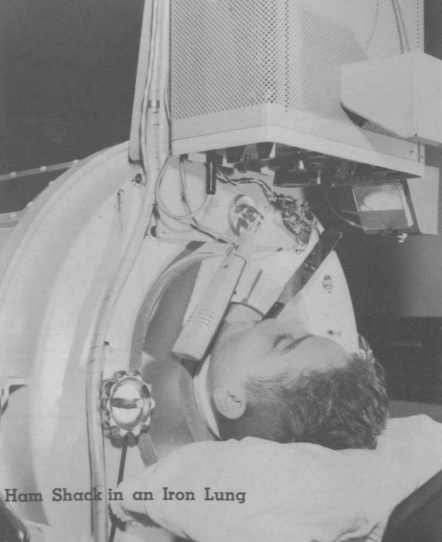I am not old enough to have to have worried about contracting polio, but I am old enough to have known people who suffered from the effects of polio. Amateur radio has always served as a window on the world for those with many types of disabilities, and I had the pleasure of meeting many hams who were handicapped as the result of polio.
Thanks mostly to the vaccines of the 1950s, North America saw its last case of polio in the 1970s, and children and their parents no longer had to worry about contracting it. But there were still many survivors of the disease when I was growing up in the 1960s and 1970s, and largely because I was a ham, I had the pleasure of meeting many of them.
One example was profiled in the December 1961 issue of QST, thirteen-year-old William F. “Billy” White III, K5CBZ, of Corpus Christi, Texas. White had been confined to an iron lung for eight years, and it was from that location where he spent all of his time, doing his school work, reading, and watching television. But recently, he had added to his repertoire the magic of amateur radio.
His first novice station was installed by a group of local hams, but could be operated only when he was out of the respirator, meaning that the time on the air was extremely limited. When he passed the Conditional test, a permanent solution had to be found. And thanks to the local hams, it was. It was decided that a Collins KWM-2 transceiver would be a good choice since it was relatively lightweight at 18 pounds and completely self contained. It was possible to mount the transceiver directly on the iron lung using fittings that were normally used for items such as mirrors and book holders. The set was mounted vertically, and could be removed and reinstalled in a matter of seconds.
Billy was able to operate the controls using a spatula held in his mouth. The only exceptions were the band switch and transmitter tuning. But when those were set, he could operate the set by himself.
During Hurricane Carla, Billy handled a considerable amount of emergency traffic from his station. When power at his house failed, the local hams delivered a generator, which powered both the radio and the iron lung.
Billy died in 1967 at the age of 19. But for the last six years of his life, as the article notes, “daily he traveled the airwaves, visiting friends, meeting new people, and filling his time through the magic of amateur radio.”
For people with disabilities who are interested in learning more about amateur radio and other assistive technology, we recommend you contact the Courage Kenny HandiHam Program, which has carried out that mission since 1967.

